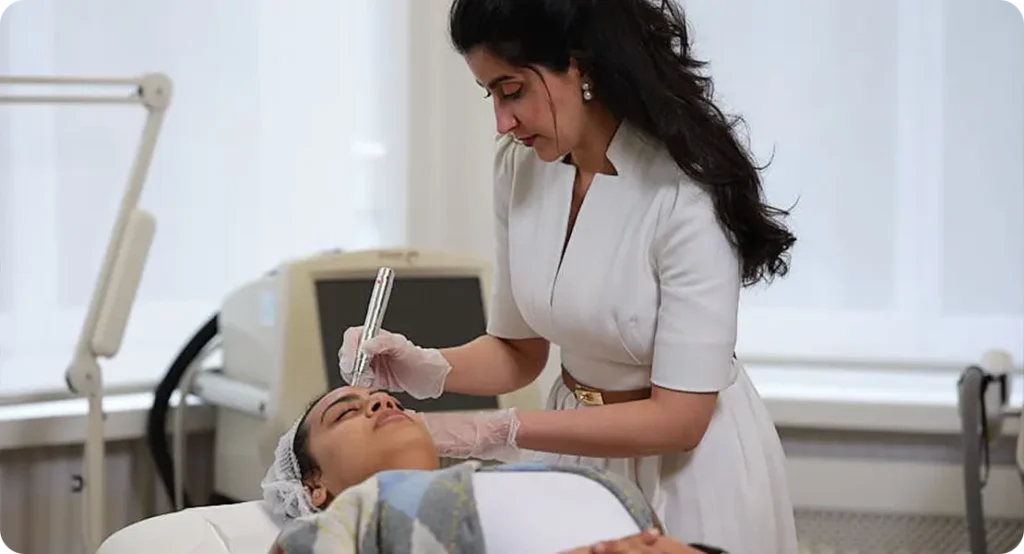Becoming a consultant dermatologist in the UK is a rigorous and lengthy process that demands dedication, academic excellence, and clinical acumen. From the initial step of gaining admission to medical school to securing a consultant post, the journey typically spans over a decade and involves a series of competitive stages, assessments, and hands-on experience.
Entry to Medical School
The first formal step in the journey to becoming a consultant dermatologist is gaining admission to a UK medical school. This process is fiercely competitive, with a limited number of places available each year. Applicants are typically expected to achieve top A-level grades—usually A*AA or higher—with Chemistry and Biology being essential subjects. Alongside academic excellence, universities also look for consistency in GCSE results, particularly in core subjects such as English, Maths, and the sciences. Strong academic performance demonstrates not only a student’s capability but also their commitment to the intellectual demands of medicine. In addition to academic qualifications, applicants are often required to sit aptitude tests such as the UCAT (University Clinical Aptitude Test) or BMAT (BioMedical Admissions Test). These exams assess a range of cognitive abilities, including logical reasoning, problem-solving, and ethical judgement, which are vital in clinical decision-making.
Each medical school has its own criteria for weighting these scores, and preparing for these tests requires a different strategy from typical school exams. Success in these assessments, combined with excellent grades, can greatly increase the chances of receiving interview offers from medical schools. Beyond test scores and academic metrics, medical schools are also interested in a candidate’s personal attributes and motivation to study medicine. This is usually assessed through personal statements and interviews, often conducted using the Multiple Mini Interview (MMI) format. Here, qualities such as empathy, communication, integrity, and teamwork are evaluated in a series of short scenarios. Gaining voluntary or paid experience in healthcare settings—such as shadowing a GP or helping in a care home—can significantly enhance an application. Such experiences not only provide insight into the medical profession but also reflect a genuine interest in helping others, which lies at the heart of any future career in dermatology.
Undergraduate Medical Training
Once admitted, students begin a demanding five- or six-year undergraduate medical degree—typically titled MBBS or MBChB—depending on the university. The curriculum is structured in two main phases: pre-clinical and clinical. The early years focus on foundational medical sciences, including human anatomy, physiology, pharmacology, and cell biology. This scientific groundwork is essential, as it forms the basis for understanding disease mechanisms, diagnostics, and treatment strategies across all specialities, including dermatology. Teaching is delivered through lectures, practical labs, tutorials, and increasingly, through problem-based learning to encourage critical thinking. As students progress, the course shifts towards clinical training. They rotate through various hospital departments and community settings to gain hands-on experience with patients under the supervision of practising doctors. These placements cover major disciplines such as internal medicine, surgery, general practice, paediatrics, psychiatry, and obstetrics and gynaecology. While dermatology is usually introduced only briefly—perhaps through a short block or a few teaching sessions—it offers a window into the specialty and can help students decide whether they wish to pursue it further. During clinical placements, students are assessed on both their theoretical knowledge and practical skills, including patient communication and professional conduct.
For those with an early interest in dermatology, there are several ways to build relevant experience during medical school. Many universities offer student-selected components (SSCs) or elective placements that allow learners to explore dermatology more deeply. These opportunities can be used to undertake supervised research projects, attend dermatology clinics, or even take part in overseas electives in dermatological care. Active participation in dermatology societies, contribution to student journals, or attending dermatology-related conferences can also enhance understanding of the field. These experiences are invaluable in developing early insight into the specialty and can later strengthen applications for dermatology training posts.

Foundation Training
After graduating from medical school, newly qualified doctors begin the Foundation Programme, a structured two-year period that provides a crucial bridge between academic study and independent clinical practice. The first year, FY1, focuses on consolidating core medical knowledge while ensuring safe and effective patient care under supervision. During this phase, doctors are provisionally registered with the General Medical Council (GMC) and gradually take on more responsibility within clinical teams. Common rotations include general medicine, surgery, emergency medicine, and psychiatry, each offering essential exposure to different aspects of patient management.
In FY2, the level of independence increases as doctors are expected to demonstrate more advanced decision-making, diagnostic reasoning, and multidisciplinary collaboration. FY2 also provides greater flexibility in rotation choices, which can be particularly beneficial for aspiring dermatologists. While dermatology placements are not universally available, some deaneries offer dedicated dermatology posts or rotations in adjacent fields such as general practice or rheumatology, both of which often involve managing skin-related conditions. Even without a direct placement, doctors can request dermatology taster sessions, which offer short-term clinical experience in the specialty and are an excellent way to gain insight and network with consultants.
Beyond clinical work, the Foundation Programme includes formal teaching, reflective practice, and workplace-based assessments. Doctors maintain an electronic portfolio where they log clinical experiences, feedback from supervisors, and evidence of achieving specific competencies. Participation in audits, quality improvement projects, and basic teaching or research initiatives can further enhance a trainee’s profile. For those aiming to pursue dermatology, this is the stage to begin tailoring their professional development by demonstrating interest in skin health, gaining relevant clinical experience, and seeking mentorship within dermatology departments.
Core Medical Training or Internal Medicine Training
Once the Foundation Programme is complete, doctors aiming for a career in dermatology must undertake further training in general internal medicine—either through the now largely replaced Core Medical Training (CMT) pathway or the newer Internal Medicine Training (IMT) programme. IMT, which lasts three years, is more commonly followed today and has been designed to provide broader and deeper training in acute and chronic medical conditions. During this period, trainees rotate through a range of specialties, including cardiology, respiratory medicine, geriatrics, and endocrinology, gaining essential skills in diagnosis, investigation, and treatment.
A major requirement during IMT is completion of the Membership of the Royal College of Physicians (MRCP) exams. This three-part examination is designed to test a doctor’s theoretical knowledge and clinical reasoning. Passing the MRCP is mandatory before applying to dermatology at the ST3 level, and it also signifies a doctor’s capability in managing complex medical problems. Preparing for these exams while balancing demanding clinical duties is a significant challenge, and success requires strategic study, time management, and often peer support. However, passing MRCP also boosts a candidate’s overall competitiveness and credibility when applying for specialist roles.
During IMT, doctors are encouraged to demonstrate a sustained interest in dermatology. This can be achieved through attending dermatology teaching days, completing audits or quality improvement projects related to skin conditions, and presenting at dermatology conferences. Some may even publish articles or case reports in medical journals, further solidifying their commitment to the specialty. Building relationships with dermatologists, attending clinics, and gathering strong consultant references are equally important. These actions not only improve clinical knowledge but also help candidates stand out in the highly competitive application process for dermatology specialty training.

Specialty Training in Dermatology
Dermatology training in the UK begins at ST3 level and spans four years, culminating in the award of a Certificate of Completion of Training (CCT). Gaining a place on this programme is exceptionally competitive, with applicants needing not only strong academic and clinical credentials but also evidence of consistent commitment to the specialty. The application process involves a national recruitment scheme, including portfolio scoring and interviews. Successful candidates must have completed IMT or CMT, passed the MRCP exams, and shown tangible engagement with dermatology through previous clinical exposure, publications, or teaching.
Once accepted into the programme, trainees are exposed to the full breadth of dermatological practice. The curriculum covers common and complex skin diseases, inflammatory conditions, skin cancers, and rare genetic disorders. Rotations also include subspecialties such as paediatric dermatology, dermatological surgery, phototherapy, and contact dermatitis. Trainees learn to perform diagnostic procedures like skin biopsies and patch testing, and they develop skills in both medical and surgical treatment options. Training is structured around supervised clinical work, academic study, multidisciplinary meetings, and attendance at regional or national training days.
Throughout specialty training, trainees must complete a series of workplace-based assessments and maintain a portfolio demonstrating progress across key competencies. They are also required to pass the Specialty Certificate Examination (SCE) in Dermatology, a nationally recognised assessment of knowledge and application in the field. Many trainees take the opportunity to contribute to research or undertake further study, such as a postgraduate diploma or master’s degree. Others may choose to develop expertise in a niche area, preparing them for consultant roles with a sub-specialist focus. Upon completing the programme and receiving CCT, doctors are eligible for inclusion on the GMC’s Specialist Register and can apply for consultant posts within the NHS or private sector.
Becoming a Consultant Dermatologist
Once dermatology specialty training is completed and all requirements have been fulfilled, doctors receive a Certificate of Completion of Training (CCT), which marks the official transition from trainee to specialist. This certification is a formal recognition of a doctor’s competence in dermatology and makes them eligible to join the General Medical Council’s Specialist Register. Being listed on the Specialist Register is a legal requirement for anyone wishing to work as a consultant in the NHS, and it also provides reassurance to employers and patients about the doctor’s qualifications and training history. At this stage, doctors can begin applying for consultant dermatologist positions throughout the UK, which may be based in teaching hospitals, district general hospitals, or specialist dermatology centres.

A consultant dermatologist holds a senior clinical role that goes far beyond diagnosing rashes or prescribing creams. These doctors are responsible for managing complex and chronic skin diseases, detecting and treating skin cancers, and performing minor surgical procedures such as biopsies, excisions, and cryotherapy. Consultants typically lead outpatient clinics, oversee specialist services such as phototherapy or patch testing, and collaborate with other departments including oncology, rheumatology, or paediatrics. The role requires a high level of decision-making, clinical independence, and the ability to manage multidisciplinary teams. Many consultants also help develop local treatment pathways and contribute to regional or national guidelines that shape dermatological care.
In addition to clinical work, consultant dermatologists often have broader responsibilities within the NHS or academic settings. Many become involved in training medical students, mentoring junior doctors, or delivering formal teaching for specialty trainees. Others contribute to clinical research, lead quality improvement initiatives, or take on management roles such as Clinical Lead or Director of Dermatology Services. Some consultants engage with professional bodies like the British Association of Dermatologists or the Royal College of Physicians, influencing policy and supporting the wider dermatology community. This mix of clinical, educational, and leadership opportunities makes the consultant role both challenging and fulfilling, offering variety and the chance to shape the future of the specialty.
How to Check the Accreditation of a Dermatologist
In the UK, it’s important to ensure that any dermatologist you consult is properly accredited and qualified. This not only safeguards patient safety but also ensures that care is being delivered by a practitioner with appropriate training and expertise. The most reliable way to check a dermatologist’s accreditation is through the General Medical Council (GMC), the regulatory body for doctors in the UK. The GMC maintains an online medical register that allows the public to verify a doctor’s credentials. By visiting the GMC’s online register, you can search by name, GMC number, or location. A fully accredited consultant dermatologist will be listed as a “Specialist in Dermatology” and will have a licence to practise.
In addition, many consultant dermatologists are members or fellows of the British Association of Dermatologists (BAD). While membership is not a regulatory requirement, it often indicates that the doctor is actively engaged in the field and adheres to the professional and clinical standards set by the organisation. The BAD also offers a searchable directory of qualified dermatologists on its website. Patients seeking private dermatology services should also check whether the practitioner is on the Specialist Register and whether they have admitting rights at reputable clinics or hospitals. Accreditation with private healthcare providers such as BUPA, AXA, or Spire Healthcare can also offer reassurance about a doctor’s standing. Lastly, reputable dermatologists are typically transparent about their qualifications and training. Their clinic or hospital profile should clearly state their medical degree, postgraduate qualifications, and any subspecialist interests. If this information is vague or missing, it’s worth making further enquiries before proceeding with treatment.

Conclusion
The pathway to becoming a consultant dermatologist is long and demanding, but for those with a strong interest in skin health and patient care, it can be immensely rewarding. From the early days of medical school to the complexities of specialty training, each stage builds the knowledge, experience, and expertise needed to excel in this highly specialised field. For patients, verifying a dermatologist’s credentials is an important step in ensuring they receive safe, expert care from a properly trained professional.
